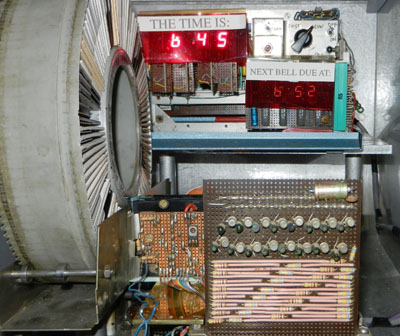The school’s current bell system was designed over 40 years ago by an OB with help from his science teacher, Alan Griffin. Many years later, this impressive feat of engineering is still in use, keeping the school to time on a daily basis.
You may never have noticed this unassuming piece of kit on display in the RTC but it has a fascinating story behind it and one that deserves celebrating. Having just successfully completed its 40th year at the controls of time-keeping at Bloxham, this instrument was designed back in 1974 by then Sixth Former Robin Youngson.
In June 1974, Robin suggested the design of an automatic slide projector to act as a card reader to program the school clock. By September, with assistance and advice from Alan Griffin, a former Science teacher at Bloxham who dedicated over 30 years to the school, the construction of the system had been completed. The system took control of ringing the school bells back in September 1974 and has been in use ever since. To this day, the bell at the top of the Chapel tower and the bells in the labs are rung thanks to Robin and Alan’s original system.
The bell system is on display on the top floor of the RTC. It is housed in a case that was especially made by OB Matthew Hagger for his 2001 A Level project, which was designed to complement the building itself and to allow the system to be linked to the Chapel and the Science labs.
Robin built the clock, and stayed with Alan for the first week of the Summer holidays in order to finish it, as he left the school at the end of the Summer term. Alan modified the projector, installing a 12 volt electric motor, so the system could be run from a car battery in case of a power failure. He also installed the electronics for the 16 photocells.
The system was originally located in the Staff Common Room (now the kitchens) and rang the bell at the top of the Chapel tower. However the official clock for “school time” at the end of the main passage was not very accurate, so Alan built an extra circuit which operated the clock, so that it agreed with the bells. (It is now the clock just above the bell system in the RTC). A further modification was running a cable to the Science labs, so that a lesson-bell could be heard there.
How does it work?
The system used by the school’s bells was cutting edge for its time and is still as reliable as ever. The design reads “slides” that pass in front of a light to represent a time. Each “slide is a two inch square of cardboard with up to 16 holes, punched in a 4×4 matrix. The clock is able to read the signals produced by the “photocells” and a display shows the next time the bells will ring.
The device also displays the correct time. When the two displays read the same time, a switch closes and the bells ring. The projector then advances to the next slide and a new time is displayed. The bell times for a whole week are stored on a circular carousel and then the cycle begins again.


